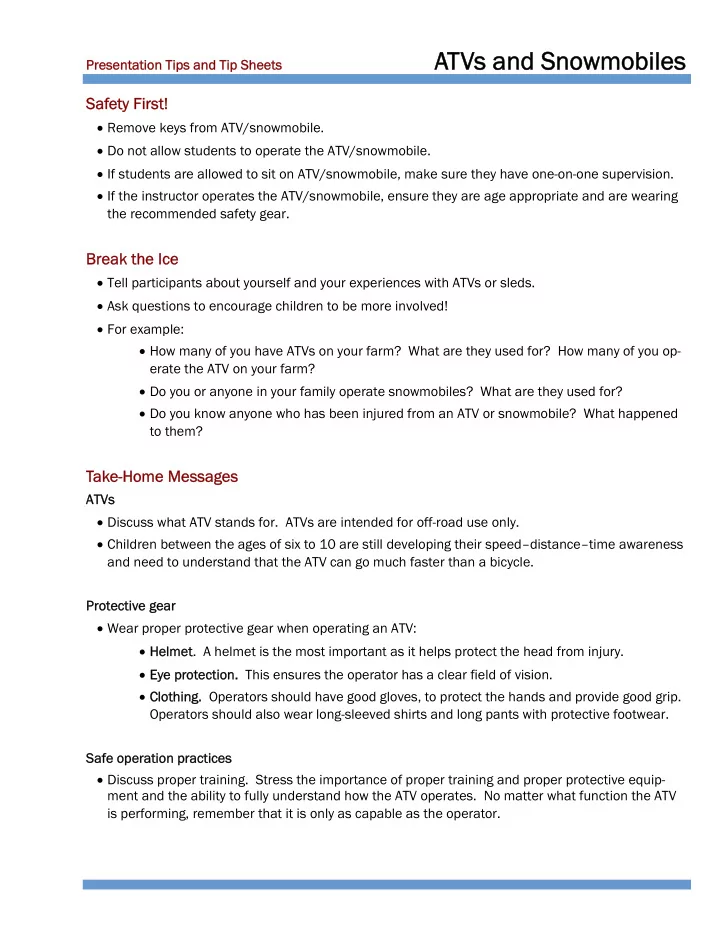

ATVs and Sno Vs and Snowmobiles wmobiles Presentation Tips and Tip Sheets Presentation Tips and Tip Sheets Safety First! Saf ty First! • Remove keys from ATV/snowmobile. • Do not allow students to operate the ATV/snowmobile. • If students are allowed to sit on ATV/snowmobile, make sure they have one-on-one supervision. • If the instructor operates the ATV/snowmobile, ensure they are age appropriate and are wearing the recommended safety gear. Break the Ice Break the Ice • Tell participants about yourself and your experiences with ATVs or sleds. • Ask questions to encourage children to be more involved! • For example: • How many of you have ATVs on your farm? What are they used for? How many of you op- erate the ATV on your farm? • Do you or anyone in your family operate snowmobiles? What are they used for? • Do you know anyone who has been injured from an ATV or snowmobile? What happened to them? Take-Home Messages -Home Messages AT ATVs Vs • Discuss what ATV stands for. ATVs are intended for off-road use only. • Children between the ages of six to 10 are still developing their speed–distance–time awareness and need to understand that the ATV can go much faster than a bicycle. Protective gear Protective gear • Wear proper protective gear when operating an ATV: • Helmet Helmet. A helmet is the most important as it helps protect the head from injury. • Eye protection. Eye protection. This ensures the operator has a clear field of vision. • Clothing. Clothing. Operators should have good gloves, to protect the hands and provide good grip. Operators should also wear long-sleeved shirts and long pants with protective footwear. Safe operation practices Safe operation practices • Discuss proper training. Stress the importance of proper training and proper protective equip- ment and the ability to fully understand how the ATV operates. No matter what function the ATV is performing, remember that it is only as capable as the operator.
ATVs and Sno Vs and Snowmobiles mobiles Presentation Tips and Tip Sheets Presentation Tips and Tip Sheets • Discuss weight-shifting issues/practices: • Shift weight to the front of the seat while going up an incline. • Shift weight to the rear while going down an incline. • Shift weight to the left/right when making a left/right turn. • Emphasize no passengers. ATVs are designed for only one rider as passengers may impair the driver’s ability to shift weight and control the ATV. • Discuss appropriate size of ATV. In order to operate the ATV safely, the operator needs to be able to safely reach the gears, brakes and all controls. The number one mistake made by parents is purchasing an ATV that is too big for their child thinking the child will soon grow into it. On an ATV that is too big, a child will often wipe out and either get hurt or become too scared to continue riding. Snowmobile Snowmo bile • Never ride with someone under the influence of alcohol. • Know your abilities and don’t go beyond them. Faster is not better! • Know your riding area. (There could be hidden dangers that you don’t know about such as elec- tric fences or large rocks under the snow.) • Make sure someone knows where you are and when you plan to return. • Wear appropriate clothing. Dress in layers so that you can add or remove layers to suit the condi- tions. • Beware of water. Don’t play on rivers or lakes. Don’t trust the judgment of other snowmobilers; just because they have driven over a river doesn’t mean you should. Drowning is a leading cause of snowmobile fatalities. • Be aware and careful of avalanche areas. Interactiv Int ractive A e Activi tiviti ties es Proper Protective Gear Proper Protective Gear • Review the proper protective gear when operating an ATV. Make this interactive by having a tote with a mixture of clothing that is both appropriate (helmet, goggles, gloves, long-sleeved shirt, long pants, closed toed shoes) for riding ATVs and inappropriate (swim trunks, flip flops, tank top, rubber gloves, etc.) Ask for a volunteer and have the students go through the items in the box and pick out the appropriate items and dress the volunteer. 2
ATVs and Sno Vs and Snowmobiles wmobiles Presentation Tips and Tip Sheets Presentation Tips and Tip Sheets • Protect your head! • Have participants try on various helmets (adult sizes vs. child sizes) and explain how to determine if the helmet is a proper fit. Use fruit such as cantaloupe or honeydew melon to demonstrate how helmets protect your head. Make sure you have an area with a hard surface such as concrete or plywood. • Place an unripe or hard cantaloupe or honeydew melon in an ATV helmet, set off to the side. Take a ripe or soft cantaloupe/honey dew melon/watermelon and drop it on the hard surface. The fruit should burst open. Explain that the melon is like a brain and this is what would happen if they were to hit their head while riding an ATV without a helmet. • Next drop the helmet with the cantaloupe/honey dew melon/watermelon in it. The fruit should not break. Explain how the helmet acts as a barrier between the environment and their head and how it protects the brain. Size appropriateness Size appropriateness • Children can learn the importance of size. Place a large adult quad beside a small child size quad so that students can see the difference in size. Have an adult sit on the child quad and ask the participants if this is appropriate. No Notes s 3
Recommend
More recommend